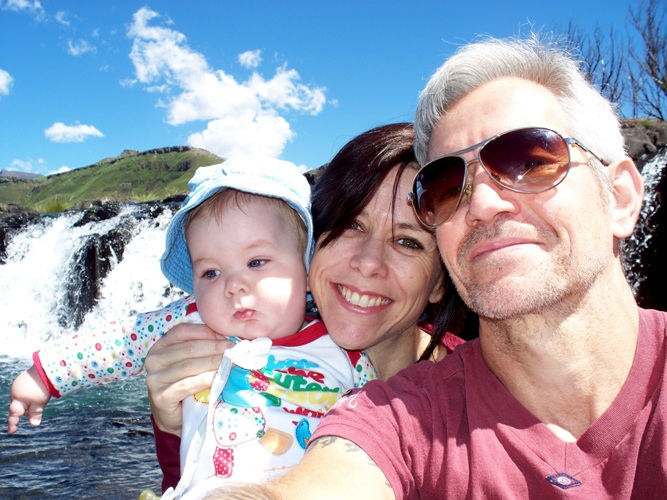“To find the enigma of Michael Broderick, you have to peel away layers. Each time you meet him, you chip away until you find the real person. He is gentle, warm and thoughtful. He is very philosophical. He is a cook though a nutcase! You look at him and want to say, “Mike, I’m very fond of you but have a decent meal, let my mom fry something up for you.” He is well read and intelligent. He is good company and talks about a variety of subjects. For a theatre person he is strangely passionate about sports and loves rugby. His life has changed because he now has a little one. He is a family man and hates being away from home. This all comes across in his lighting. He is very subtle.” – Dave Whitehouse
Modest and reserved, Michael is not his best promoter but his work speaks for him where he does not; he’s a highly sought after Lighting Designer. He has also kept pertinent with his involvement as a consultant, technical director for many years at the Hilton Festival, lecturer, and more recently providing training on lighting equipment. Entering the industry by accident, it’s difficult to imagine his talent being used quite so wonderfully anywhere else.
“I met Michael in the theatre, the shy, famously talented (& yummy) lighting designer. We’ve been together almost 12 years,” comments his wife Stacey Taylor-Broderick. “With being together a long while comes familiarity which means you often don’t really ‘see’ each other and what’s noticeable or outstanding to others because you know ‘your someone’ so well. That’s why I love watching the pieces Michael lights…because I see him anew; that unique, remarkable talent and the magic he brings to every piece he works on jolts me and I am once again gobsmacked and goosebumped by the subtle beauty that only he can create in quite that way. And then I see him ‘from the outside’; not as my husband but as an exceptional talent. And in every piece I recognise two things; his incredible gift, and his passion for what he does. And I believe they are the things that set him apart.”
It took time for young Michael to find his feet. One of six children, the others all excelling at school, Michael was a disinterested student who matriculated in 1980. His father was unyielding: Michael had to have a steady job which led him to work in a bank for seven years, completing his national service during this time.
In 1987 he ventured to the UK and found himself, as a young South African, unable to work in the country. Assistance came in the form of an illegal employment agency that provided Michael with a social security number and the assumed name of ‘Philip’ in return for a chunk of his small cheque. ‘Philip’ worked temporarily for Kimpton Walker, the renowned scenery construction company, as a painter and sweeper. It was fascinating for him to see sets being built including a structure manufactured for the Rolling Stones tour but “I thought it was a life beyond me,” remembers Michael.
When he returned to South Africa, he was aimless and living off the Unemployment Insurance Fund. Michael’s sister convinced him to study further. “I’ll lend you the money, just give it a shot,” she said. “If you don’t like it after a year you can leave.”
As the Journalism and Photography classes he wanted to pursue were fully booked, Michael made a last minute decision to enrol for the Theatre Technology course at the Durban Technical College, a happy and fortuitous change.
The next three years were marvellous. “We had such a good time,” he remembers. “At the time, the drama and technical departments were run in conjunction with each other. Every year a third year drama student had to direct a play so throughout the year there was a continuous stream of theatre plays running Mondays to Thursdays with the first and second technical year students assigned to assist with make-up, costuming, set, sound and lighting.” And Michael volunteered for every production. He loved sound, but believing that a sound person should be able to play a musical instrument, he focussed on lighting instead. And there he accidentally found his true talent and passion.
With college out the way, Michael was immediately employed by Graham Eales. However, within four months Graham handed in his notice and relocated to New Zealand, joining Philips Selecon. He recommended that Michael fill his position, and under the mentorship of senior partner Nic Michaletos, Michael was exposed to the industry at a rapid rate, it was sink or swim and fortunately with Nic’s guidance he managed to survive.
So for the next six years, he ran Production Projects Durban with the assistance of a bookkeeper. The day arrived when Michael was also offered a position at Philips Selecon, New Zealand. “I didn’t plan it very well,” Michael recalls. “I left without a work VISA but I think it boils down to the fact that I didn’t place enough emphasis on emigrating.” He arrived to his worst nightmare, a desk job that would entail hiring out gear from what was then a tiny operation. He left soon after which turned out to be the right decision but he regretted leaving his friend and boss Graham in the lurch.
Brandon Bunyan, a good friend of Michael from college days, still remembers the phone call he made to Michael at the time. “Come back and let’s start a company,” he asked. Brandon had all of six stage pieces, four parcans and a dream to provide a service for theatrical productions.
The pair toured with the Romeo and Juliet ballet in a 1989 Isuzu bakkie and a trailer visiting Port Elizabeth, East London and Cape Town, a thrilling time of sleepless nights mixed with the excitement of making things happen. With a passion to succeed, Brandon would drive to Hillcrest, a 45 minute drive from Durban, to drop off a single lamp for a client. “He knew he was building a name, and where Brandon has got to over the years is amazing,” said Michael. “He also has a great team and it’s because he leads by example.”
With a desire to find achievement on his terms while exploring an inner skill, Michael decided to fly solo, kicking off his career with minor shows in Durban venues. “As any lighting person knows, you do the best you can with what you have,” he said, and this was good enough to get the attention of the press. In fact, he was one of the first designers in Durban to be consistently noted for his work and experiments with lighting.
Durban has never had the earning potential that the Johannesburg and Cape Town Theatre scene has so one is always trying to create magic with the bare minimum of instruments and technology. This apparent drawback has been instrumental in defining my lighting style. I love technology but I am still a “less is more” theatre person at heart’. The challenge of creating magic with little more than a few lights, inspiration and raw talent is what gets Michaels heart racing.
His most recent work includes lighting West Side Story which ran at The Playhouse and as the Set and Lighting Designer for the Playhouse Company’s staging of the opening ceremony for the BRICS Conference at the ICC. “I love the thrill and intensity that a large scale production brings. The challenges and pressures give rise to Faustian moments where time is the devil on your shoulder and the “we’ll just do what we can under the circumstances” excuse people often fall back on just challenges me to dig deeper to achieve my own level of excellence.’ He regularly works with long term friend, Aaron Mcllroy, their latest tour being with the show The Rise of the Insanity League, & more recently, Seven Deadly Sins where he created both the set & the lighting. The highlights of his career so far have been his work with The Fantastic Flying Fish Dance Company, namely ‘Grass Gardens’ and David Gouldie’s ‘Off Axis’, The avant garde edginess being right up his alley. He is also particularly fond of his past work with Opera Africa (La Traviata, Rigoletto and La Boheme) ‘mainly because Opera is a fantastic medium to light’. He has great memories of creating the set and lighting for the annual Durban Designer Collection for a number of years whilst still working for Production Projects. ‘Nic Michaletos was instrumental in pushing the boundaries, inspiring me to do the same.’ From time to time Michael presents lectures, pleased if he is able to inspire & influence someone’s career and help them get the skills to get there faster. He has also staged a number of his own shows, writing and directing his own work at various festivals around South Africa.
Since 1996, Michael has been the technical director for the popular Hilton Festival. In his self-deprecating manner, he says he just cleverly puts talented people in the right positions but in reality it’s a large, very complicated task that takes great organisation and logistics, technical know-how, and the ability to smoothly appease the artistic temperaments of the casts and directors, while ensuring that every measure is taken to provide a technically outstanding festival. “Michael is a gentleman,” commented Dave Whitehouse from DWR. “I see how he treats the guys working at the Hilton. He is very respectable and temperate.”

![Inspired by Michael Broderick 1 D48_500_michael_pic[1]](https://dwrdistribution.co.za/wp-content/uploads/2014/02/D48_500_michael_pic1-300x200.jpg)
![Inspired by Michael Broderick 2 3AC_500_IMG_3089[1]](https://dwrdistribution.co.za/wp-content/uploads/2014/02/3AC_500_IMG_30891-300x224.jpg)




